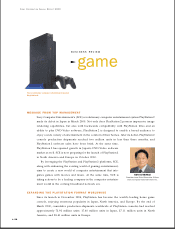Sony 2000 Annual Report Download - page 21
Download and view the complete annual report
Please find page 21 of the 2000 Sony annual report below. You can navigate through the pages in the report by either clicking on the pages listed below, or by using the keyword search tool below to find specific information within the annual report.
SONY CORPORATION ANNUAL REPORT 2000
19
can be easily enjoyed as a home theater system. In video decks, sales weakened as com-
petition exerted downward pressure on prices and the market continued to mature. Halting
color TV production in Germany at the end of December 1999 was one way in which HNC
reorganized its existing operations.
While shifting AV product lines from analog to digital, HNC is also creating new forms of fun
within the context of digital networks. During the year under review, HNC began selling the
Memory Stick Walkman in Japan and the U.S. The unit
incorporates Sony’s MagicGate Memory Stick IC recording
media, which protects copyrighted material. It is easily
portable and almost impervious to shocks. In the U.S., HNC
entered into alliances with TiVo, Inc., which offers an auto-
matic recording service whereby customers can personalize
their TV viewing, and with Cablevision Systems Corp., which
provides cable TV service in the New York metropolitan
area. In May 2000, HNC began selling digital network recorders
that store TV programs on a hard disk and are designed for
TiVo’s service. For Cablevision Systems, HNC plans to supply
approximately three million digital set-top boxes which can
deliver video-on-demand of movies and television programs,
interactive games, and other forms of entertainment.
The main products of the Personal IT Network Company
(PNC) include home-use camcorders, digital still cameras,
telecommunications products, home-use PCs, and related
products. During the year under review, in place of sales of
8mm analog camcorders, sales of DV format camcorders and
Digital8 camcorders, which record and playback digital format
as well as playback analog recordings on 8mm tape, were
strong. Sales of VAIO home-use PCs, which feature unique
functions and stylish exteriors, posted dramatic increases in Japan, the U.S., and Europe. Digital
still cameras using the IC recording media Memory Stick or floppy disks to store pictures also
performed well. On the other hand, in the North American digital cellular phone business, where
results have been consistently weak, at the end of September 1999 PNC ceased engineering,
sales, and marketing activities, excluding research and development and after-sales service.
PNC instead shifted resources to the Japanese and European cellular phone markets as part of
its drive to become more focused.
To create new forms of enjoyment in the digital network era, PNC aims to develop new
product categories. In November 1999, PNC started collaborating with Palm Computing, Inc. of
the U.S. to develop a next-generation platform for handheld consumer electronics products
equipped with AV functions. The first model is scheduled to go on sale during the second half
of the fiscal year ending March 31, 2001.
This Memory Stick Walkman, which
went on sale in December 1999,
employs a MagicGate Memory Stick to
offer a new way to enjoy music. This
IC recording media incorporates tech-
nology to prevent unauthorized copy-
ing, making the Walkman the
industry’s first product to conform to
SDMI (Secure Digital Music Initiative)
standards for the protection of digital
music content.
























